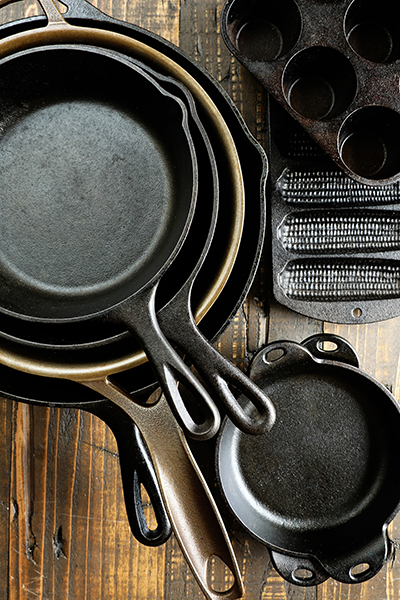Simply Seasoned: Caring For Cast Iron

By Stacey Little
If there was a fire at our house, the first things I’d save are my family, dog and great-grandmother’s cast iron skillet. Heather, Jack and Ella are obviously first, but that skillet is a family heirloom. I can’t imagine the number of biscuits baked in it or the amount of chicken it fried to perfection. It has fed countless mouths — thousands, I’m sure. When my great-grandmother passed 18 years ago, that skillet was the greatest treasure that could have been bequeathed.
It’s a workhorse now, too. It’s not reverently displayed on a high shelf. It gets used weekly, because that’s what BigMama would want. It’s heavy and a little rough around the edges, but the inside is slick as glass. Nothing sticks. That’s what makes it amazing.
Cast iron cookware, like this skillet, holds heat well. It’s virtually indestructible. It’s easy to use. It’s great for cooking anything from eggs to grilled cheese to cornbread.
For some, the care and cleaning of cast iron can be intimidating, but with a few helpful hints, you’re sure to become a pro.
Seasoning
Seasoning a cast iron skillet is one of the most important things you can do. It’s the process of applying very thin layers of fat and cooking them at high temperatures. The fats polymerize and form a hard, plastic-like coating on the iron surface. This coating makes the pan nonstick. Each time you cook with it, another layer is added, so the more you use it, the better it gets.
While many new products come pre-seasoned, I find the factory seasoning isn’t enough. I prefer to buy cast iron unseasoned (or bare) and season it myself. It takes time but is pretty painless.
Start by washing the skillet with hot, soapy water. Dry it completely. Turn the oven to 200 F and place the skillet in the oven to warm. After 10 minutes, remove the skillet and use a lint-free towel to apply an incredibly thin layer of vegetable oil over the surface — inside and out, handle and all. Wipe off the oil with another cloth. That may seem strange, but we only want a microscopically thin layer of oil left on the skillet. Too much and the surface can get sticky.
I always use vegetable oil, such as soybean or canola, or vegetable shortening for seasoning a skillet. They’re easily found, affordable and work well.
Next, place the skillet upside down on the oven rack and increase the heat to 500 F or as high as your oven goes. Bake 1 hour. Baking upside down prevents pools of oil from forming sticky spots.
Turn the oven off and allow the skillet to cool enough to handle — at least 30 minutes.
Once cool enough to handle but still warm, apply another thin layer of oil and wipe off the excess. Turn the oven back up to 500 F and place the skillet in the oven, upside down, for another hour. Repeat three or four times to get the best finish.
Cleaning
Growing up, I was taught to never ever put soap in a cast iron skillet. But modern science says we can use a mild, nonabrasive soap if needed. That hard, polymerized coating on a seasoned skillet is like plastic and takes more than soap to wash away.
I typically wash the skillet with hot water and use a plastic scraper or a couple tablespoons of kosher salt to scrub the hard-to-clean bits — only using soap if it’s absolutely necessary. Don’t use abrasive scouring pads and cleaners as they damage the finish. Then dry it and wipe a thin coating of oil over the surface; use another cloth to wipe off the excess. Place the skillet back in the warm oven or on the stovetop over low heat to ensure it’s completely dry.
Store cast iron with cloths or paper towels between them as stacking can scratch the seasoning.
Cooking
In most cases, you’ll want to heat the skillet before cooking with it. This is especially true with cornbread and when searing.
Be cautious about the utensils you use. Wood, plastic and silicone are best, as metal tools can damage the seasoning.
Though a quick dash of lemon juice won’t cause much harm, slow cooking acidic things like tomato sauce in cast iron can start to break down the seasoning.
Troubleshooting
A round or two of the seasoning method should correct most issues, such as rust or a damaged finish. Scrub the pan in hot, soapy water and follow the seasoning steps.
If it’s more serious, you can always start from scratch. Run the cookware through your oven’s self-cleaning cycle. The high-temperature will burn off old seasoning and built up gunk. Cool the skillet completely, wash with hot, soapy water, and season.
